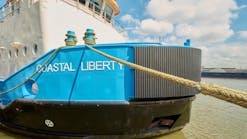Offshore sectors must adopt united front to meet energy transition goals
Editor's note: This Beyond the Horizon column first appeared in the September-October 2022 issue of Offshore magazine. Click here to view the full issue.
By Jason Brown, Head of UK Renewables, Aker SolutionsThe offshore wind industry and the offshore oil and gas industry share common ground in pursuit of decarbonization targets and improved economics. The offshore wind industry has never been more focused on driving down costs, as evidenced by the recent Contracts for Difference round in the UK and the laser-focus among developers and operators on supplying global markets with the most competitive electricity possible.
Volume is also key, however, as the energy transition accelerates and the offshore wind sector – whether fixed or floating, for utilities, electrification or green hydrogen, or as part of mixed-energy fields – gears up to meet 2030 and 2050 ambitions.
The twin drivers of economy and speed have put a premium on effective and efficient engineering and project management from the earliest project stages through contracting, construction and into operations and decommissioning.
And established expertise, including from oil and gas, can facilitate savings across project lifecycles – safeguarding finance, accelerating the path to first wind, and engineering out costs while maintaining high standards of safety and reliability.
New thinking is required. The pace of offshore wind development and construction is accelerating simultaneously across multiple markets around the world, which will put a huge strain on the available skills and resources.
Other segments are also on the march: concerns over security of supply and growing demand have put newbuild gas on the fast track, particularly in Asia-Pacific, while emerging sectors including CCS and hydrogen are gaining momentum.
This environment will place a premium on early action and forward planning, which will be crucial to securing the resources and expertise necessary to execute and operate projects on time and on budget – meeting the expectations of customers and investors.
The cost of any delay will go beyond lost production to encompass reputational damage, contracting complications, commercial challenges and financial impacts. Mitigating those risks will be key – through predictable deliveries, standardized components, innovative solutions and streamlined economics.
And the positive impacts can extend across the sector; this is not just about pure play offshore wind developers, but also encompasses the increasing number of traditional energy companies pursuing a strategy of diversification and/or decarbonization through renewables and adjacent technologies.
Clawing costs out of offshore wind can start at the earliest stage of any project and will pay benefits including accelerating timelines to first wind by up to a third. This has a knock-on impact in terms of increased revenues and returns.
It starts with proactive planning for design, contracting and delivery even before consents are in hand, by leveraging proven relationships across the supply chain, forging partnerships across industry, and tapping into an established heritage of building massive energy projects.
The approach will, crucially, facilitate the industrialization and standardization that can drive further cost savings in offshore wind, particularly when experienced fabrication yards and manufacturers are brought into the fold at the earliest stage.
Alliances are equally important in this regard; experience from oil and gas suggests that a different approach to the more traditional project-by-project tendering process can shave months if not years off development timelines across the energy sector.
Also key will be the technical advances that in many cases are coming from the oil and gas side of the energy equation: semisubmersibles and floating substation platforms, dynamic cabling and the subsea substation – these will be game changers for offshore electrification.
All of which, of course, is built on an industry-wide foundation which prioritizes a strong health and safety regime. This will be necessary to minimize risk in the increasingly crowded and complicated offshore energy space.
The renewables community should take advantage of the experience of companies with a proven track record of success in the harshest of environments. Likewise, an oil and gas sector fully committed to the energy transition – and what this means in terms of diversification, electrification, decarbonization and security of supply – can no longer consider offshore wind as a sideshow, or a second-best option.
Sharing transferable common ground is key. Lessons can be learned from the oil and gas industry’s experience of operating in offshore environments, particularly when it comes to advancing floating wind systems. Offshore wind’s ability to produce clean energy can help decarbonize offshore oil and gas operations through electrification. This will facilitate what everyone wants: a reliable, safe and cost-effective energy sector that overcomes hurdles and bottlenecks to meet consumer demand while addressing climate concerns – at speed.
In general, the industry understands the size of the challenge, and has many of the tools needed to succeed. This is true on several fronts – in manufacturing; through integration across a complex project landscape; by using multiple low-carbon technologies; and with the power of digitalization driving industrialization and standardization.
If we are to succeed, as a combined and committed energy industry, there can be no silos, no divas, no grandstanding. Just cooperation, collaboration, innovation and shared goals. And a lot of hard work.





